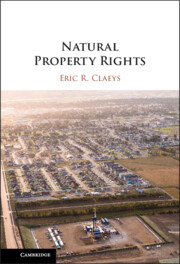Book contents
- Natural Property Rights
- Natural Property Rights
- Copyright page
- Contents
- Acknowledgments
- Note on Cover
- Table of Cases
- Table of Legislative Materials
- Table of Multiple Edition Works
- Part I Foundations
- Part II The Natural Right to Property
- 4 Property’s Subject Matter and Interest
- 5 Property’s Elements and Scope
- 6 Property’s Conceptual Structure
- 7 Property, Natural Law, and Nozick
- Part III Property Law
- Part IV Property in Common Law and Public Law
- Index
- References
5 - Property’s Elements and Scope
from Part II - The Natural Right to Property
Published online by Cambridge University Press: 17 April 2025
- Natural Property Rights
- Natural Property Rights
- Copyright page
- Contents
- Acknowledgments
- Note on Cover
- Table of Cases
- Table of Legislative Materials
- Table of Multiple Edition Works
- Part I Foundations
- Part II The Natural Right to Property
- 4 Property’s Subject Matter and Interest
- 5 Property’s Elements and Scope
- 6 Property’s Conceptual Structure
- 7 Property, Natural Law, and Nozick
- Part III Property Law
- Part IV Property in Common Law and Public Law
- Index
- References
Summary
This chapter studies the elements of an interest-based natural property right. To acquire a prima facie right in a resource, the claimant must use it productively and claim exclusivity to its use in terms others will understand. But the prima facie right may be overridden by either of two provisos. The sufficiency proviso limits property rights when a proprietor’s use of a resource does not leave others sufficient access to the same type of resource for their own needs. The necessity proviso limits natural rights when someone who does not hold property in a resource needs access to it to repel some serious threat to life or property. This chapter illustrates legal doctrines for capturing animals and other articles of personal property, occupying unowned land, and appropriating water flow by use. This chapter contrasts productive use with Locke’s treatments of labor, waste, and spoliation, and it contrasts claim communication with Pufendorf and Grotius’s treatments of possession. This chapter also considers familiar criticisms of rights-based property theories, involving hypotheticals with radioactive tomato juice or ham sandwiches embedded in cement.
Keywords
- Type
- Chapter
- Information
- Natural Property Rights , pp. 82 - 104Publisher: Cambridge University PressPrint publication year: 2025

